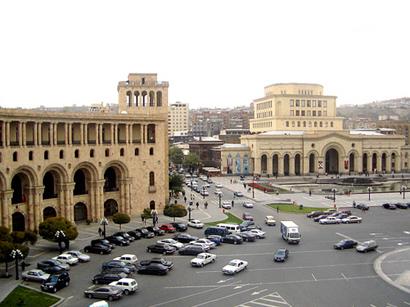
Another State Fiction Of Armenia As Result Of Pressure From Baku
BAKU, Azerbaijan, October 5. Very remarkable holidays are sometimes marked in different countries of the world, and these aren't always harmless curiosities, reports.
So, for example, Bolivia, which lost access to the sea as a result of the Second Pacific War at the end of the 19th century, keeps its fleet on Titicaca lake and annually marks the Day of the Sea as a message to everyone (and, above all, to itself) that it didn't accept the defeat and still expects to retake the lost territories.
However, mono-ethnic Armenia has been celebrating the Day of National Minorities in recent times. It's clear that this was done under the influence of a successful information attack by Baku, and first of all, after the words of the President of Azerbaijan Ilham Aliyev, who compared mono-ethnic Armenia with a one-color carpet, drawing the attention of the international community to the mono-ethnicity of Armenia, surrounded on four sides by poly-ethnic Azerbaijan, Georgia, Türkiye and Iran, where sometimes residents of neighboring villages speak different languages.
The Prime Minister of Armenia Nikol Pashinyan has even published a special message on this occasion where he made hypocritical statements such as 'the national minorities of Armenia, as part of the family of the peoples of the world, constitute an integral part of the population of Armenia, enriching Armenia with their original identity', 'by securing this day in the list of holidays of our country, we wish to draw public attention to a small but important part of our country: representatives of different nationalities living side by side, to their identity, recognition and problem solving', and others.
They only forgot to indicate whether these national minorities exist in Armenia.
Of course, to 'depict violent activity', for example, Rimma Varzhapetyan can be displayed in the media as the head of the Jewish community, but in reality, Armenia is one of the few countries where it's impossible in principle to get an education in a language other than Armenian.
There is a school in Fioletovo village of Armenia where teaching is conducted in Russian, but this educational institution is under the patronage of the Russian embassy and teaching there follows the Russian curriculum. Under frank pressure, Russian classes were opened, but they only accept children who have at least one parent who isn't Armenian by nationality.
However, one fact is far more important. Armenia was created on the lands of the Azerbaijani Iravan Khanate, and before the Turkmanchay Treaty, signed in the first half of the 19th century, there was no noticeable Armenian presence there. The resettlement of Armenians began already on the basis of the Turkmanchay Treaty.
Nevertheless, even in 1828, taking into account the escape of tens of thousands of Muslims to Iran and the Ottoman Empire and the resettlement of 120,000 Armenians from there to Iravan, Karabakh, and Nakhchivan, the arrival of the Russian army in Iravan with its convoy, the share of Muslims in the population of the Iravan Khanate exceeded 70 percent. That is, the Armenians themselves were a national minority in these lands, but then...
Biologists, or rather, ornithologists, know this well: cuckoos, barely hatched from eggs thrown by their mother, immediately throw their native chicks out of the nest. The Armenians who resettled to the lands of the Iravan Khanate behave in exactly the same way. First, against the backdrop of resettlement, a massive seizure of lands that belonged to the indigenous inhabitants, the Azerbaijanis, began.
In 1918, against the backdrop of the collapse of the Russian Empire, Armenian nationalists committed mass ethnic cleansing of Azerbaijanis in Zangazur, and the leader of the Armenian gangs, Garegin Nzhdeh, who later served the Nazis, called this destruction of villages as 'liberation'. In the Soviet years, deportations of Azerbaijanis took place, and after 1988, the indigenous Azerbaijani population of Armenia was completely expelled from there.
At the same time, there was an 'ethnic cleansing' of toponymy. On the maps compiled by Russian military topographers, not Armenian, but only Turkic and Azerbaijani names of rivers, villages, cities, mountains, and lakes were indicated.
To date, all historical toponymy on the maps of Armenia has been erased. Istisu became 'Jermuk', the Zanga river - 'Hrazdan', Goycha lake - 'Sevan' etc.
No less barbaric was the 'ethnic cleansing' of architecture. In this regard, the destruction of the historical buildings of Iravan - six of the seven mosques, the Khan's palace, and the Iravan fortress can be reminded. As a result, Yerevan doesn't have its historical center, and then the same thing happened in the Azerbaijani Karabakh during its Armenian occupation. Everyone who wasn't born an Armenian - Azerbaijanis, Kurds, Greeks, and Russians - was also expelled from there.
As a result of continuous ethnic cleansing, about one million people became refugees and internally displaced persons. In Karabakh, 65 out of 67 mosques, residential buildings, museums, schools, and cemeteries were destroyed. Armenized names were given to Azerbaijani cities and villages: Jabrayil became 'Jrakan', Lachin - 'Berdzor', Fuzuli - 'Varanda' etc.
Armenia, which turned into a xenophobic mono-ethnic 'island' surrounded by a multi-ethnic South Caucasus, pursued the same policy in Karabakh, and now the Armenian authorities have decided to make a kind of 'rebranding' by declaring 'Day of National Minorities' in their country, but who, besides professional lobbyists, will buy into this cheap trick?

Legal Disclaimer:
MENAFN provides the
information “as is” without warranty of any kind. We do not accept
any responsibility or liability for the accuracy, content, images,
videos, licenses, completeness, legality, or reliability of the information
contained in this article. If you have any complaints or copyright
issues related to this article, kindly contact the provider above.























Comments
No comment